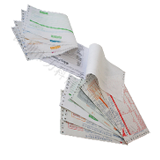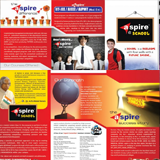- Call us: +9144 65373256/+91 98400 17317
- Email us: aksharaforms@yahoo.com
Continuous Computer Stationery Manufacturer in Chennai.
Welcome to Akshara
Products
A leading manufacturer of Continuous Stationery Forms for Computers is also called in western countries as Business Forms. These forms are made using specialized papers with interleaved One-time Carbon Papers. On a further development customers started using Carbonless Continuous Stationery. These are made for the use of Tax Invoice, Excise Challans, Export Invoice, Delivery Challans, Packing Slips, Form JJ, Purchase Orders, Payment Vouchers, Blank and EZR Forms.
Added to the above, we can offer you offset printing requirement like Brochure, Catalogues, Phamplets, leaflets, Envelopes, Letter Head, Receipts, Vouchers etc., using Single Color and Multicolor Offset Printing. Furthermore, we also offer a wide range of Printing Machinery spares for offset, Paper, and Packaging Industries.
Read about process of printing
Process Of Printing
The actual process of printing is quite involved. One of the most important functions in the process is pre-press production. This stage makes sure that all files are correctly processed in preparation for printing. This includes converting to the proper CMYK color model, finalizing the files, and creating plates for each color of the job to be run on the press.
Every printing technology has its own identifying marks, as does offset printing. In text reproduction, the type edges are sharp and have clear outlines. The paper surrounding the ink dots is usually unprinted. The halftone dots are always hexagonal though there are different screening methods.
Variations
Blanket-to-blanket: A printing method in which there are two blanket cylinders through which a sheet of paper is passed and printed on both sides. Blanket-to-blanket presses are considered a perfecting press because they print on both sides of the sheet at the same time. Since the blanket-to-blanket press has two blanket cylinders, making it possible to print on both sides of a sheet, there is no impression cylinder. The opposite blanket cylinders act as an impression cylinder to each other when print production occurs. There are also two plate cylinders on the press.
Blanket-to-steel: A printing method similar to a sheet offset press; except that the plate and cylinder pressures are quite precise. Actual squeeze between plate and blanket cylinder is optimal at .005"; as is the squeeze or pressure between the blanket cylinder and the substrate. Blanket-to-steel presses are considered one-color presses. In order to print the reverse side, the web is turned over between printing units by means of turning bars. The method can be used to print business forms, computer letters, and direct mail advertising.
Variable-size printing: A printing process that uses removable printing units, inserts, or cassettes for one-sided and blanket-to-blanket two-sided printing.
Dry Offset Printing: A printing process which uses a metal backed photopolymer relief plate, similar to a letterpress plate, but, unlike letterpress printing where the ink is transferred directly from the plate to the substrate, in dry offset printing the ink is transferred to a rubber blanket before being transferred to the substrate.
Computer-to-plate (CTP) / direct-to-plate (DTP)
Computer-to-plate (CTP) is a newer technology that allows the imaging of metal or polyester plates without the use of film. By eliminating the stripping, compositing, and traditional plate making processes, CTP altered the printing industry, which led to reduced prepress times, lower costs of labor, and improved print quality.
Printing – Offset & Multicolor Offset
Computer-to-plate (CTP) is a newer technology that allows the imaging of metal or polyester plates without the use of film. By eliminating the stripping, compositing, and traditional plate making processes, CTP altered the printing industry, which led to reduced prepress times, lower costs of labor, and improved print quality.
Printing – Offset & Multicolor Offset
Sheet-fed refers to individual sheets of paper or paperboard being fed into a press via a suction bar that lifts and drops each sheet onto place. A lithographic ("litho" for short) press uses principles of lithography to apply ink to a printing plate, as explained previously. Sheet-fed litho is commonly used for printing of short-run magazines, brochures, letter headings, and general commercial (jobbing) printing. In sheet-fed offset, “the printing is carried out on single sheets of paper as they are fed to the press one at a time.” Sheet-fed presses use mechanical registration to relate each sheet to one another to ensure that they are reproduced with the same imagery in the same position on every sheet running through the press.
Perfecting press: A perfecting press, also known as a duplex press, is one that can print on both sides of the paper at the same time. Web and sheet-fed offset presses are similar in that many of them can also print on both sides of the paper in one pass, making it easier and faster to print duplex.
Offset duplicators: Small offset lithographic presses that are used for fast, good quality reproduction of one- and two-color copies in sizes up to 12” by 18”. Offset duplicators are made for fast and quick printing jobs; printing up to 12,000 impressions per hour. They are able to print business forms, letterheads, labels, bulletins, postcards, envelopes, folders, reports, and sales literature.
Feeder system: The feeder system is responsible for making sure paper runs through the press correctly. This is where the substrate is loaded and then the system is correctly set up to the certain specifications of the substrate to the press.
Printing/inking system: The Printing Unit consists of many different systems. The dampening system is used to apply dampening solution to the plates with water rollers. The inking system uses rollers to deliver ink to the plate and blanket cylinders to be transferred to the substrate. The plate cylinder is where the plates containing all of the imaging are mounted. Finally the blanket and impression cylinders are used to transfer the image to the substrate running through the press.
Advantages of offset printing compared to other printing methods include:
- Consistent high image quality. Offset printing produces sharp and clean images and type more easily than, for example, letterpress printing; this is because the rubber blanket conforms to the texture of the printing surface.
- Quick and easy production of printing plates.
- Longer printing plate life than on direct litho presses because there is no direct contact between the plate and the printing surface. Properly developed plates used with optimized inks and fountain solution may achieve run lengths of more than a million impressions.
- Cost. Offset printing is the cheapest method for producing high quality prints in commercial printing quantities.
- A further advantage of offset printing is the possibility of adjusting the amount of ink on the fountain roller with screw keys. Most commonly, a metal blade controls the amount of ink transferred from the ink trough to the fountain roller. By adjusting the screws, the gap between the blade and the fountain roller is altered, leading to the amount of ink applied to the roller to be increased or decreased in certain areas. Consequently the density of the color in the respective area of the image is modified. On older machines the screws are adjusted manually, but on modern machines the screw keys are operated electronically by the printer controlling the machine, enabling a much more precise result.
- Another process is CTCP (computer to conventional plate) system in which conventional offset plates can be exposed, making it an economical option and also polymerization rather than by evaporation or absorption.
Inks
Offset duplicators: Offset printing uses inks that, compared to other printing methods, are highly viscous. Typical inks have a dynamic viscosity of 40–100 Pas
There are many types of paste inks available for utilization in offset lithographic printing and each have their own advantages and disadvantages. These include heat-set, cold-set, and energy-curable (or EC), such as ultraviolet- (or UV-) curable, and electron beam- (or EB-) curable. Heat-set inks are the most common variety and are "set" by applying heat and then rapid cooling to catalyze the curing process. They are used in magazines, catalogs, and inserts. Cold-set inks are set simply by absorption into non-coated stocks and are generally used for newspapers and books but are also found in insert printing and are the most economical option. Energy-curable inks are the highest-quality offset litho inks and are set by application of light energy. They require specialized equipment such as inter-station curing lamps, and are usually the most expensive type of offset litho ink.
- Letterset inks are mainly used with offset presses that do not have dampening systems and uses imaging plates that have a raised image.
- Waterless inks are heat-resistant and are used to keep silicone-based plates from showing toning in non-image areas. These inks are typically used on waterless Direct Imaging presses.
- Single Fluid Inks are newer ink that uses a process allowing lithographic plates on a lithographic press without using a dampening system during the process.
Ink/water balance
Ink and water balance is an extremely important part of offset printing. If ink and water are not properly balanced, the press operator may end up with many different problems affecting the quality of the finished product, such as emulsification (the water overpowering and mixing with the ink). This leads to scumming, catchup, trapping problems, ink density issues and in extreme cases the ink not properly drying on the paper; resulting in the job being unfit for delivery to the client. With the proper balance, the job will have the correct ink density and should need little further adjustment except for minor ones. An example would be when the press heats up during normal operation, thus evaporating water at a faster rate. In this case the machinist will gradually increase the water as the press heats up to compensate for the increased evaporation of water. Printing machinists generally try to use as little water as possible to avoid these problems.
Today, offset lithography is "responsible for over half of all printing using printing plates" The consistent high quality of the prints and the volume of prints created for their respective cost makes commercial Multicolor offset is very efficient for businesses, especially when many prints must be created.
Hosted and maintained by Legend IT Solutions.
















 +91 98400 17317
+91 98400 17317 aksharaforms@yahoo.com
aksharaforms@yahoo.com